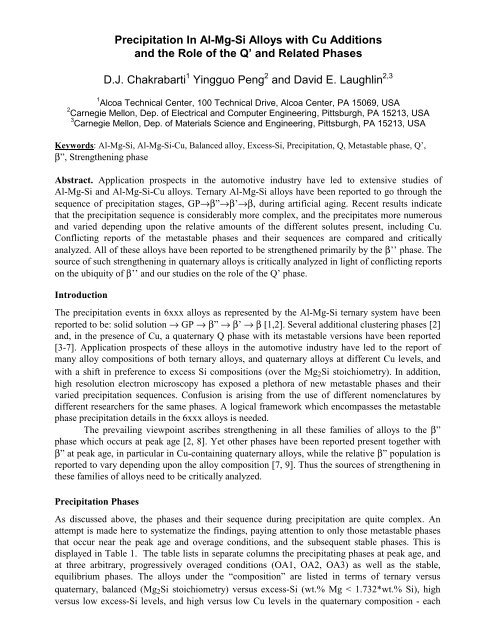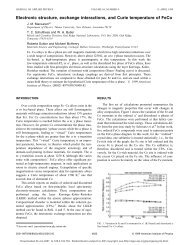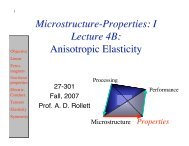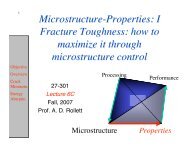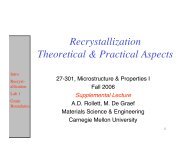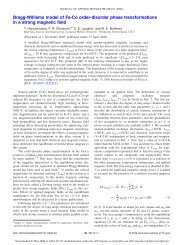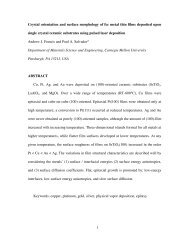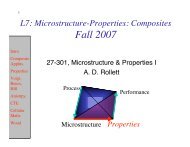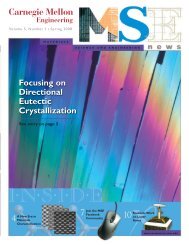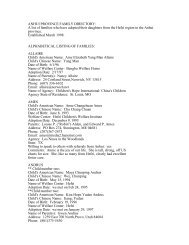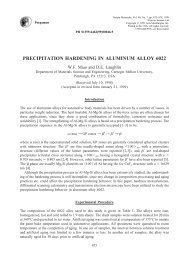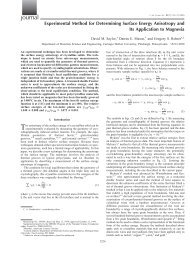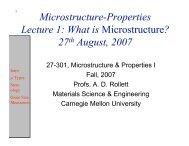Precipitation In Al-Mg-Si Alloys with Cu - Materials Science and ...
Precipitation In Al-Mg-Si Alloys with Cu - Materials Science and ...
Precipitation In Al-Mg-Si Alloys with Cu - Materials Science and ...
You also want an ePaper? Increase the reach of your titles
YUMPU automatically turns print PDFs into web optimized ePapers that Google loves.
<strong>Precipitation</strong> <strong>In</strong> <strong>Al</strong>-<strong>Mg</strong>-<strong>Si</strong> <strong>Al</strong>loys <strong>with</strong> <strong>Cu</strong> Additions<br />
<strong>and</strong> the Role of the Q’ <strong>and</strong> Related Phases<br />
D.J. Chakrabarti 1 Yingguo Peng 2 <strong>and</strong> David E. Laughlin 2,3<br />
1 <strong>Al</strong>coa Technical Center, 100 Technical Drive, <strong>Al</strong>coa Center, PA 15069, USA<br />
2 Carnegie Mellon, Dep. of Electrical <strong>and</strong> Computer Engineering, Pittsburgh, PA 15213, USA<br />
3 Carnegie Mellon, Dep. of <strong>Materials</strong> <strong>Science</strong> <strong>and</strong> Engineering, Pittsburgh, PA 15213, USA<br />
Keywords: <strong>Al</strong>-<strong>Mg</strong>-<strong>Si</strong>, <strong>Al</strong>-<strong>Mg</strong>-<strong>Si</strong>-<strong>Cu</strong>, Balanced alloy, Excess-<strong>Si</strong>, <strong>Precipitation</strong>, Q, Metastable phase, Q’,<br />
β”, Strengthening phase<br />
Abstract. Application prospects in the automotive industry have led to extensive studies of<br />
<strong>Al</strong>-<strong>Mg</strong>-<strong>Si</strong> <strong>and</strong> <strong>Al</strong>-<strong>Mg</strong>-<strong>Si</strong>-<strong>Cu</strong> alloys. Ternary <strong>Al</strong>-<strong>Mg</strong>-<strong>Si</strong> alloys have been reported to go through the<br />
sequence of precipitation stages, GP→β”→β’→β, during artificial aging. Recent results indicate<br />
that the precipitation sequence is considerably more complex, <strong>and</strong> the precipitates more numerous<br />
<strong>and</strong> varied depending upon the relative amounts of the different solutes present, including <strong>Cu</strong>.<br />
Conflicting reports of the metastable phases <strong>and</strong> their sequences are compared <strong>and</strong> critically<br />
analyzed. <strong>Al</strong>l of these alloys have been reported to be strengthened primarily by the β’’ phase. The<br />
source of such strengthening in quaternary alloys is critically analyzed in light of conflicting reports<br />
on the ubiquity of β’’ <strong>and</strong> our studies on the role of the Q’ phase.<br />
<strong>In</strong>troduction<br />
The precipitation events in 6xxx alloys as represented by the <strong>Al</strong>-<strong>Mg</strong>-<strong>Si</strong> ternary system have been<br />
reported to be: solid solution → GP → β” → β’ → β [1,2]. Several additional clustering phases [2]<br />
<strong>and</strong>, in the presence of <strong>Cu</strong>, a quaternary Q phase <strong>with</strong> its metastable versions have been reported<br />
[3-7]. Application prospects of these alloys in the automotive industry have led to the report of<br />
many alloy compositions of both ternary alloys, <strong>and</strong> quaternary alloys at different <strong>Cu</strong> levels, <strong>and</strong><br />
<strong>with</strong> a shift in preference to excess <strong>Si</strong> compositions (over the <strong>Mg</strong>2<strong>Si</strong> stoichiometry). <strong>In</strong> addition,<br />
high resolution electron microscopy has exposed a plethora of new metastable phases <strong>and</strong> their<br />
varied precipitation sequences. Confusion is arising from the use of different nomenclatures by<br />
different researchers for the same phases. A logical framework which encompasses the metastable<br />
phase precipitation details in the 6xxx alloys is needed.<br />
The prevailing viewpoint ascribes strengthening in all these families of alloys to the β”<br />
phase which occurs at peak age [2, 8]. Yet other phases have been reported present together <strong>with</strong><br />
β” at peak age, in particular in <strong>Cu</strong>-containing quaternary alloys, while the relative β” population is<br />
reported to vary depending upon the alloy composition [7, 9]. Thus the sources of strengthening in<br />
these families of alloys need to be critically analyzed.<br />
<strong>Precipitation</strong> Phases<br />
As discussed above, the phases <strong>and</strong> their sequence during precipitation are quite complex. An<br />
attempt is made here to systematize the findings, paying attention to only those metastable phases<br />
that occur near the peak age <strong>and</strong> overage conditions, <strong>and</strong> the subsequent stable phases. This is<br />
displayed in Table 1. The table lists in separate columns the precipitating phases at peak age, <strong>and</strong><br />
at three arbitrary, progressively overaged conditions (OA1, OA2, OA3) as well as the stable,<br />
equilibrium phases. The alloys under the “composition” are listed in terms of ternary versus<br />
quaternary, balanced (<strong>Mg</strong>2<strong>Si</strong> stoichiometry) versus excess-<strong>Si</strong> (wt.% <strong>Mg</strong> < 1.732*wt.% <strong>Si</strong>), high<br />
versus low excess-<strong>Si</strong> levels, <strong>and</strong> high versus low <strong>Cu</strong> levels in the quaternary composition - each
one of which noticeably modifies the precipitation processes. <strong>Al</strong>so added in Table 1 are crystal<br />
structure <strong>and</strong> lattice parameter information for the different phases according to the sequence in<br />
which they occur under the specific columns. Some of the phases shown <strong>with</strong>in parentheses were<br />
added for completeness, but were not specifically mentioned in the quoted works.<br />
Table 1. <strong>Precipitation</strong> Sequence <strong>and</strong> Precipitate Structure for Different 6xxx <strong>Al</strong>loy Compositions<br />
Composition Peak Age OA 1 OA 2 OA 3 Equilibrium Ref.<br />
Ternary, Excess <strong>Si</strong> β ” + β ”<br />
d<br />
Ternary, Excess-<strong>Si</strong> (low) β<br />
M β<br />
7<br />
” β ’ Ternary, Excess-<strong>Si</strong> (high) β<br />
+ Type B Type C β + <strong>Si</strong> 5, 6<br />
” β ’ + Type A Type A <strong>Si</strong> + β 5, 6<br />
Ternary, Balanced β ” β ’ + β ” β ’ β ’ Balanced + low <strong>Cu</strong> β<br />
β<br />
1, 2<br />
” + L L + β ’ + β ” L + β ’ β ’ Balanced + high <strong>Cu</strong> β<br />
+ L β + λ (Q) + (θ) 7<br />
” + L L + β ” L λ (Q) + β + (θ) 7<br />
Excess <strong>Si</strong> + low <strong>Cu</strong> β ” β ” β ” Q ’ Excess <strong>Si</strong> + high <strong>Cu</strong> β<br />
(<strong>Si</strong>) + Q + (θ) 9<br />
” + Q ’ β ” + Q ’ β ” + Q ’ Q + (β) + (θ) 9<br />
<strong>Al</strong>-<strong>Mg</strong>-<strong>Si</strong>-<strong>Cu</strong> β ” + QP QC+QP+β ’ Q ’ Q+(<strong>Si</strong> or β)+(θ) 12, 13<br />
---------------------------------------------------------------------------------------------------------------------------------------------------------------------------------------<br />
β ” β ’ β<br />
Monoclinic Hexagonal <strong>Cu</strong>bic<br />
a=0.65nm, b=0.76nm (a=0.705, c=0.405)nm a=0.642 nm<br />
c=0.405nm, γ=70°<br />
L Q ’ Q, λ<br />
----- Hexagonal Hexagonal<br />
(a=0.8, c=0.7)nm (a=1.03, c=0.405)nm (a=1.04, c=0.405)nm<br />
λ d ” M<br />
--------- (a=1.03, c=0.405)nm<br />
QP QC B ’<br />
Hexagonal Hexagonal Hexagonal<br />
(a=0.393, c=0.405)nm (a=0.67, c=0.405)nm (a=1.03, c=0.405)nm<br />
Type B Type C<br />
Hexagonal Hexagonal<br />
(a=0.67, c=0.405)nm (a=1.04, c=0.401)nm<br />
Type A<br />
Hexagonal<br />
(a=0.405, c=0.67)nm<br />
A representative of the ternary alloy precipitation is the “Ternary Balanced” case. Here the<br />
precipitates are the needle shaped β” phase <strong>with</strong> a monoclinic structure at peak age, a mixture of<br />
β” <strong>and</strong> hexagonal β’ progressively approaching β’ <strong>with</strong> overaging, <strong>and</strong> the equilibrium cubic β<br />
phase (<strong>Mg</strong>2<strong>Si</strong>) [1,2]. The “Excess-<strong>Si</strong> + low <strong>Cu</strong>” case represents the quaternary alloy [9]. Here the<br />
precipitate at peak age is still cited as β”, while a new phase originally designated as B’ by Dumolt<br />
et al. [4], which is identical to the hexagonal Q’ phase, precursor to Q, appears at over age <strong>and</strong><br />
leads to the equilibrium Q phase. (To clear some confusion, Dumolt et al. studied the commercial<br />
6061 alloy that contains 0.18-0.3% <strong>Cu</strong> - hence a quaternary alloy - <strong>and</strong> the B’ phase for which they<br />
provided detailed precipitate structure referred to the metastable precursor phase of Q, which is<br />
better termed Q’ [10].) For “Excess-<strong>Si</strong> + high <strong>Cu</strong>” alloy, Q’ occurred together <strong>with</strong> β” at peak age<br />
[9]. For the “Balanced + low <strong>Cu</strong>” alloy (0.65<strong>Si</strong>, 1<strong>Mg</strong>, 0.25<strong>Cu</strong>), a new lath-shaped phase L is cited<br />
to occur at peak age along <strong>with</strong> β”, for which only the lattice parameter but no crystal structure<br />
data are available [7]. Apparently the L phase is different from Q’ <strong>and</strong> occurs as a precursor to Q’<br />
<strong>and</strong> is present at peak age through over age, while Q’ more often occurs at over age. The same L<br />
phase also occurs in “Balanced + high <strong>Cu</strong>” alloy (0.65<strong>Si</strong>, 0.87<strong>Mg</strong>, 1<strong>Cu</strong>), but as the <strong>Cu</strong> additions
increase the relative proportion of L to β” phase at peak age increases [7]. The L phase also<br />
becomes more prominent <strong>with</strong> overaging.<br />
<strong>Precipitation</strong> in ternary excess-<strong>Si</strong> alloys provides a notable contrast to that in ternary<br />
balanced alloy. Segalowicz et al. [7] observed β” present at peak age together <strong>with</strong> a lath shaped<br />
metastable phase, designated βd”, that preferentially precipitated on dislocations. This phase was<br />
replaced on over aging by a phase termed M. M, which has similar lattice parameters, crystal<br />
structure (hexagonal) <strong>and</strong> morphology (lath) as the quaternary metastable phase Q’, was the only<br />
phase present on prolonged over aging (OA3). However, it was replaced later by β the stable<br />
equilibrium phase. Matsuda et al. [5,6] reported the occurrence of a lath-shaped, hexagonal<br />
metastable phase, denoted as Type B, on over aging which was replaced on prolonged over aging by<br />
another metastable phase, termed Type C, in a “Ternary, Excess-<strong>Si</strong> (low)” alloy. Type C which<br />
shares similar precipitate characteristics as M <strong>and</strong> Q’ (see Table 1) was replaced, as was M, by β the<br />
stable equilibrium phase. A metastable hexagonal phase Type A, different from Type B, was<br />
observed by the same authors in “Ternary, Excess-<strong>Si</strong> (high)” alloys, which was replaced at<br />
equilibrium directly by the stable (<strong>Si</strong>) phase. The above studies clearly indicate that metstable<br />
phase(s) sharing the precipitate characteristics of the quaternary metastable Q’ phase can be formed<br />
in over aged ternary alloys <strong>with</strong> excess <strong>Si</strong> content. This is noteworthy, since Q is stable only as a<br />
quaternary phase, while a metastable version of it can be formed even in ternary alloys in the<br />
presence of excess <strong>Si</strong>.<br />
The existence of a metastable ternary phase (termed M by [7] <strong>and</strong> Type C by [5]) that has a<br />
similar structure as the Q' phase is an interesting finding. The Q phase has a structure similar to<br />
that of Th7S12 in which <strong>Si</strong> atoms take the place of the Th atoms <strong>and</strong> <strong>Al</strong> <strong>and</strong> <strong>Mg</strong> atoms are r<strong>and</strong>omly<br />
placed on the sites occupied by S in the prototype structure. <strong>In</strong> addition, <strong>Cu</strong> atoms are thought to<br />
be placed at other sites that are not occupied in the Th7S12 structure [11]. One explanation of the<br />
ternary Q' like phase (M or Type C) is that these sites are not occupied in the ternary structure. The<br />
structure has the same space group designation as the Q phase <strong>and</strong> similar lattice parameters <strong>and</strong><br />
would be practically indistinguishable from the Q phase by normal diffraction techniques.<br />
Detailed systematic studies including high resolution TEM by Cayron et al. [12,13] on <strong>Al</strong>-<br />
<strong>Mg</strong>-<strong>Si</strong>-<strong>Cu</strong> alloys, derived from reactions in metal matrix composites, also revealed several<br />
metastable phases to Q, namely the hexagonal QP at peak age <strong>and</strong> the hexagonal QC similar to<br />
Type B on over age. It has been shown by Cayron that the sequence of precipitation:<br />
QP → QC → Q<br />
can be understood as an atomic ordering process <strong>with</strong>in the basal plane of the hexagonal lattice.<br />
The c lattice parameter is the same for each of the phases (see Table 1) while the a lattice parameter<br />
varies from that of QP to 3 times that of QP (QC phase) to 7 times that of QP (Q phase).<br />
These different phases have the same stacking sequence of the basal planes (ABAB…) but different<br />
arrangements of atoms <strong>with</strong>in the basal planes. This proposal of Cayron nicely ties together several<br />
of the structures shown in Table 1.<br />
Strengthening Phases<br />
Numerous studies indicate that the strengthening phase involved in the <strong>Al</strong>-<strong>Mg</strong>-<strong>Si</strong> ternary alloys is<br />
the metastable β” phase [2, 8]. This phase is a precursor to the metastable β’ phase which in turn is<br />
a precursor to the equilibrium β phase. Thus, the increased strengthening in excess-<strong>Si</strong> alloys has<br />
been ascribed to a greater volume fraction of β” formation. <strong>In</strong> quaternary <strong>Al</strong>-<strong>Mg</strong>-<strong>Si</strong>-<strong>Cu</strong> alloys, the<br />
strength was observed to increase progressively <strong>with</strong> increasing <strong>Cu</strong> additions. Here again some<br />
ascribed this to the formation of more β” <strong>and</strong> in finer sizes. <strong>In</strong> what follows, these interpretations<br />
will be analyzed <strong>with</strong> reference to some of our experimental results <strong>and</strong> some recent literature data.
We conducted experiments in which <strong>Al</strong>-<strong>Mg</strong>-<strong>Si</strong>-<strong>Cu</strong> samples were studied for hardness<br />
variation <strong>with</strong> artificial aging times. The variations were compared against the systematic changes<br />
in equilibrium phases <strong>and</strong> their calculated relative amounts in samples of selected composition<br />
levels. Several such groups of samples were studied, the results from one of which is presented<br />
Figure 1. The five compositions were selected in a way such that the calculated volume fraction of<br />
Q phase at 177°C progressively increased reaching a plateau, while those of β (<strong>Mg</strong>2<strong>Si</strong>) <strong>and</strong> θ<br />
(<strong>Cu</strong><strong>Al</strong>2) correspondingly decreased. Figure 1 shows several inserts, one for the composition of the<br />
five alloys studied (a), another for the volume fraction of different equilibrium phases present at the<br />
artificial aging temperature 177°C calculated from the equilibrium phase diagram (b), <strong>and</strong> a plot for<br />
the hardness (Rockwell-B) variations <strong>with</strong> aging times at 177°C (c). Prior to the artificial aging, the<br />
book mold cast ingots were subjected to the st<strong>and</strong>ard processing steps of homogenization, hot<br />
rolling, solution treatment, quenching <strong>and</strong> natural aging. The hardness results show a systematic<br />
increase mirroring the increase in Q phase amount, even though the amounts of β <strong>and</strong> θ phases,<br />
both well known for the strengthening capability of their precursor phases, decreased. Assuming<br />
that the relative amounts of the precursor phases are proportional to the relative amounts of the<br />
stable phases, this then offers the interesting possibility that a precursor phase of Q has a significant<br />
strengthening capability.<br />
(a)<br />
4.5<br />
Specimen Composition (wt.%)<br />
Number <strong>Mg</strong> <strong>Si</strong> <strong>Cu</strong><br />
S798 1.18 0.61 0.90<br />
S799 1.17 0.81 0.93<br />
S800 1.19 1.03 0.94<br />
S801 1.20 1.13 0.95<br />
S802 1.22 1.36 0.88<br />
4<br />
3.5<br />
3<br />
2.5<br />
2<br />
1.5<br />
1<br />
0.5<br />
0<br />
Calculated Volume Percent of Equilibrium Phases at 177°C<br />
Versus <strong>Al</strong>loy Composition<br />
Q<br />
<strong>Cu</strong><strong>Al</strong>2<br />
<strong>Mg</strong>2<strong>Si</strong><br />
(<strong>Si</strong>)<br />
S798 S799 S800 S801 S802<br />
<strong>Al</strong>loy No.<br />
(b)<br />
Hardness Versus Aging Time at 177°C<br />
for Different <strong>Al</strong>-<strong>Mg</strong>-<strong>Si</strong>-<strong>Cu</strong> <strong>Al</strong>loy Compositions<br />
Figure 1. <strong>Al</strong>loy Compositions (a), Calculated Equilibrium Phases (b) <strong>and</strong> Hardness <strong>with</strong> Aging<br />
Time (c) Results<br />
Literature reports, however, indicate that the phase present at peak age in <strong>Al</strong>-<strong>Mg</strong>-<strong>Si</strong>-<strong>Cu</strong><br />
alloys is primarily β”, while Q’ is generally present during overaging <strong>and</strong> would be thus associated<br />
<strong>with</strong> decreases in strength [2,8]. Thus, the Q’ precursor phase of Q does not appear to be a<br />
strengthening phase capable of explaining the results of Figure 1. <strong>In</strong> contrast, in one study the<br />
strength of an <strong>Al</strong>-<strong>Mg</strong>-<strong>Si</strong> balanced alloy was reported to increase progressively <strong>with</strong> increased<br />
additions of <strong>Cu</strong>. A concomitant increase in the population of a phase having rectangular cross<br />
section <strong>and</strong> containing <strong>Cu</strong> was observed in the TEM [14]. <strong>In</strong> the earlier mentioned work of<br />
Segalowicz et al. [7], the proportion of L increased <strong>with</strong> increased <strong>Cu</strong> additions. On overaging the<br />
L phase eventually led to another lath shaped phase which they termed λ or Q. <strong>In</strong> excess-<strong>Si</strong> ternary<br />
75<br />
70<br />
65<br />
60<br />
(C)<br />
S798<br />
S799<br />
S800<br />
S801<br />
S802<br />
0 5 10 15 20 25 30 35 40<br />
Aging Time at 177°C (hrs)
alloys lath shaped phases λd” [7] <strong>and</strong> Type B, which is precursor to Type C as described earlier [5],<br />
also were reported. Our high resolution TEM studies on a quaternary alloy (sample no. S802 in<br />
Fig. 1) that has a large amount of Q phase as an equilibrium phase in near peak age conditions<br />
show both the β" precursor phase to β' <strong>and</strong> another phase <strong>with</strong> a lath shape that is most likely the L<br />
phase identified by Sagalowicz et al. [7]. See Figure 2. <strong>In</strong> Figure 2(a) three precursor precipitates<br />
are shown edge on, only one of which is β" as can be seen from Figure 2 (b) <strong>and</strong> (c) <strong>and</strong> comparing<br />
<strong>with</strong> Figure 4 of Andersen et al. [15] Thus, at peak age along <strong>with</strong> the normal needle-shaped β”<br />
phase, a lath-shaped phase also is present. This lath shaped precursor phase to Q (different from<br />
Q’) therefore plays a strong role on the strengthening process in quaternary alloys. Thus,<br />
composition changes that show increases in the equilibrium Q phase can be indicative of<br />
corresponding increases in the lath shaped precursor phase <strong>with</strong> its significant strengthening<br />
capability, confirming the inference from the results in Figure 1. According to the above results<br />
<strong>and</strong> interpretation, though neither Q or Q’ has recognizable strengthening potential, the lath-shaped<br />
precursor phases to Q’ does play a significant role in the strengthening of <strong>Al</strong>-<strong>Mg</strong>-<strong>Si</strong>-<strong>Cu</strong> alloys.<br />
Further work is in progress.<br />
Figure 2. High resolution TEM image of alloy S802 showing several metastable phases (a). The<br />
phase enlarged in (b) is β” <strong>and</strong> that enlarged in (d) is a lath shaped phase similar to L. Fourier<br />
transforms of images (b) <strong>and</strong> (d) are those in (c) <strong>and</strong> (e), respectively.<br />
Summary <strong>and</strong> Conclusions<br />
• Complex combinations of precursor phases, as revealed by high resolution TEM, are observed<br />
in <strong>Al</strong>-<strong>Mg</strong>-<strong>Si</strong>-(<strong>Cu</strong>) alloys as influenced by <strong>Mg</strong> to <strong>Si</strong> ratio (balanced versus excess), level of<br />
excess <strong>Si</strong>, presence of <strong>Cu</strong> or <strong>Cu</strong> level.<br />
• The quaternary metastable phase, Q’, is isostructural <strong>with</strong> Q (hexagonal) <strong>with</strong> similar lattice<br />
parameters, but is smaller in size, <strong>and</strong> is coherent along its c-axis <strong>with</strong> the <strong>Al</strong> matrix. It has<br />
been also called B’ in the literature.<br />
• The precipitate types <strong>and</strong> forming sequences listed in Table 1 for the three composition groups<br />
(ternary excess <strong>Si</strong>, balanced <strong>and</strong> quaternary alloys) suggest the following:<br />
o A phase similar to Q’, <strong>with</strong> the same crystal system <strong>and</strong> lattice parameter as Q (termed<br />
variously as M <strong>and</strong> Type C), can be formed in excess <strong>Si</strong> alloys <strong>with</strong>out <strong>Cu</strong>, but is
metastable. On overaging, it is replaced by β <strong>and</strong>/or (<strong>Si</strong>) instead of forming an equilibrium<br />
Q like phase.<br />
o <strong>In</strong> quaternary alloys <strong>with</strong> <strong>Cu</strong>, both metastable Q’ <strong>and</strong> equilibrium Q phases are formed.<br />
o <strong>Si</strong>milar to β’ having the precursor phase β”, precursor phases <strong>with</strong> the lath morphology<br />
exist for the Q’ phase, for example “L” for quaternary <strong>and</strong> “βd” for ternary excess <strong>Si</strong><br />
compositions.<br />
• <strong>In</strong> <strong>Al</strong>-<strong>Mg</strong>-<strong>Si</strong>-<strong>Cu</strong> quaternary alloys, significant strengthening effects arise from the lath shaped,<br />
hexagonal precursor phase(s) to Q’ in addition to the generally recognized β” phase.<br />
Acknowledgments<br />
DJC wishes to thank the <strong>Al</strong>coa management for their support of this study <strong>and</strong> approval of its<br />
publication.<br />
References<br />
[1] G. Thomas: J. <strong>In</strong>st. Met., Vol. 90 (1961-62), p. 57.<br />
[2] G.A. Edwards, K. Stiller, G.L. Dunlop <strong>and</strong> M.J. Couper: Acta Mater., Vol. 46 (1994), 3893.<br />
[3] G. Phragman : J. <strong>In</strong>st. Met., Vol. 77 (1950), p. 489.<br />
[4] S.D. Dumolt, D.E. Laughlin <strong>and</strong> J.C. Williams: Scr. Met., Vol. 18 (1984), p.1347.<br />
[5] K. Matsuda, Y. Uetani, T. Sato <strong>and</strong> S. Ikeno: Met. <strong>and</strong> Mater. Trans.,Vol. 32A (2001), p.1293.<br />
[6] K. Matsuda: Private communication.<br />
[7] L. Sagalowicz, G. Hug, D. Bechet, P. Sainfort & G. Lapasset: ICAA-4 (Trans Tech<br />
Publication, Switzerl<strong>and</strong> 1994), p. 636.<br />
[8] W.F. Miao <strong>and</strong> D.E. Laughlin: J. Mat. Sci., Vol 19 (2000), p. 201.<br />
[9] A. Perovic, D.D. Perovic, G.C. Weatherly <strong>and</strong> D.J. Lloyd: Scrip. Met., Vol. 41 (1999), p.703.<br />
[10] D.J. Chakrabarti, B.K. Cheong <strong>and</strong> D.E. Laughlin: Automotive <strong>Al</strong>loys (TMS, USA 1998), p. 27.<br />
[11] L. Arnberg <strong>and</strong> B. Aurivillius, Acta Chem. Sc<strong>and</strong>., Vol. A34 (1980), p. 1.<br />
[12] C. Cayron, L. Sagalowicz, O. Beffort <strong>and</strong> P.A. Buffat: Phil. Mag., Vol. 79 (1999), p. 2833.<br />
[13] C. Cayron, These No. 2246 (Ecole Polytech. Fed. Lausanne, 2000).<br />
[14] M. Tamizifar <strong>and</strong> G. W. Lorimer: ICAA-3 (Trans Tech Pub., Switzerl<strong>and</strong> 1992), p. 220.<br />
[15] S.J. Andersen, H. W. Z<strong>and</strong>bergen, J.J. Jansen, C.Traeholt, U. Tundal <strong>and</strong> O. Reiso: Acta.<br />
Mater., Vol. 46 (1998), p. 3283.


